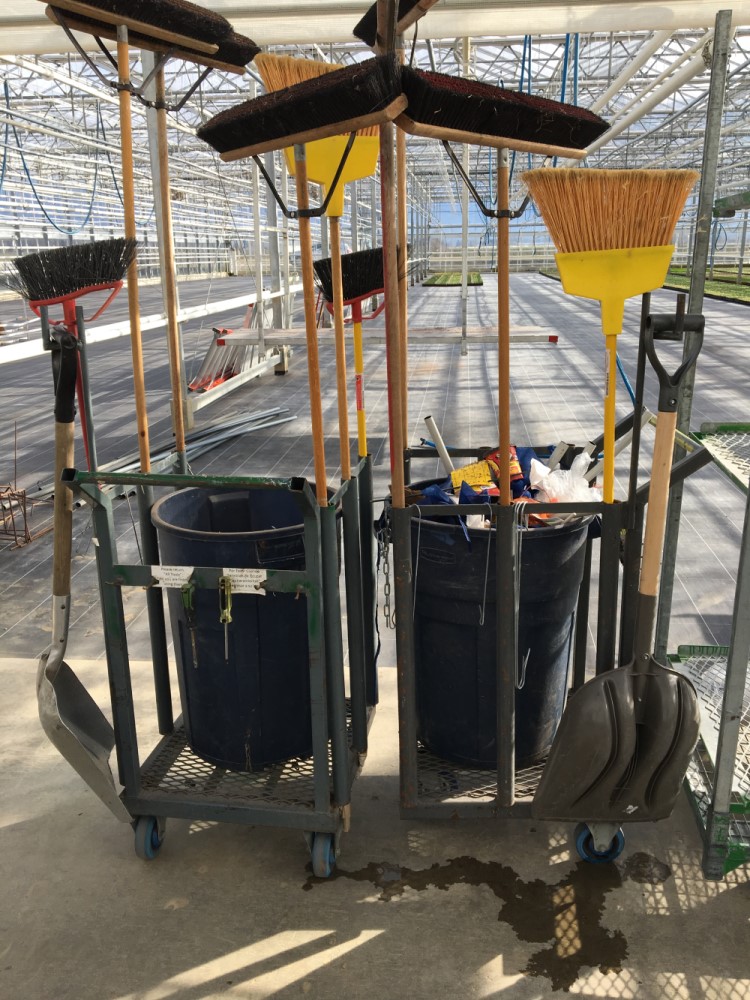Please click here to access the main AHDB website and other sectors.
- Home
- Knowledge library
- Clean-up procedures with ornamental crops
Clean-up procedures with ornamental crops
Site clean-up, combined with disinfection, is critical in preventing the carryover of pathogens, pests and weeds between crops/seasons.
Back to: Guidelines on nursery hygiene for outdoor and protected ornamental crops
Clean-up procedures can vary by crop and production system:
For outdoor crops, a comprehensive annual nursery clean-up, including treatment of standing areas, is generally satisfactory, usually during the summer as these areas become empty.
For protected crops, treatment is usually in late summer, just before the start of autumn production, or in late winter following crops such as poinsettia or cyclamen before spring bedding production.
- Remove all dead plants, weeds and crop debris from the area to be cleaned. Sweep or vacuum up dust, debris and growing media from benches, pathways and standing areas
- Remove debris from the glasshouse or cropping area in a sealed container. Sweepings commonly contain spores of the black root rot fungus (Thielaviopsis basicola) and may contain other pathogens and pests. Transport debris in covered skips or trailers for disposal at a compost heap or a local authority disposal site, or have it collected
- Where composting, apply to the Environment Agency for an exemption from the Agricultural Waste Regulations (T23 waste exemption: aerobic composting and associated prior treatment). Site any compost heap at least 10 m away from the glasshouse or cropping area
- Wash down all structures and surfaces using a pressure washer before applying a disinfectant. Detergents can be used where water is insufficient to remove accumulated dirt. Thorough cleaning before disinfection reduces the risk of re-infestation and improves the efficacy of some disinfectant products
- Check the effectiveness of disinfectants against specific plant pathogens to maximise their effect
- Apply disinfectants to both the floor and the structure if needed (bear in mind any corrosive properties of the products used)
- Irrigation pipes and nozzles should be cleaned, for example by flushing, or soaking them with acid to remove limescale or a disinfectant
Remember, the following areas need cleaning:
- Glasshouse structure
- Floors, benches and other propagation or production areas such as potting areas
- Matting and other floor or bench covers (brush clean, power hose and disinfect or replace)
- Containers and trays if reused
- Irrigation systems
- Transplanting machines and associated equipment and areas
- Storage areas, for example, cold stores
Useful links
Read the AHDB crop walker guides for bedding and pot plants, cut flowers and hardy nursery stock to familiarise yourself with the range of issues encountered in the production of ornamentals.
Crop Walkers' Guide: Bedding and pot plants
Crop Walkers' Guide: Cut flowers
Crop Walkers' Guide: Hardy Nursery Stock
For further information on the choice and use of chemical disinfectants, see AHDB Factsheet 03/14 ‘Use of disinfectants in protected ornamental plant production’.
Factsheet: Use of disinfectants in protected ornamental plant production
Authors
The content for these web pages were originally authored for AHDB by:
Author(s) – Dave Kaye and Erika Wedgwood. ADAS Horticulture.
Original author(s) – Tim O’Neill, Wayne Brough, John Atwood and Jude Bennison, ADAS.
Webpage content correct as of June 2021.
Got a question? Ask a member of the team:
Nursery-designed cleaning trollies make clean-up procedures more organised

Image © AHDB
Topics:
Sectors:
Tags:

